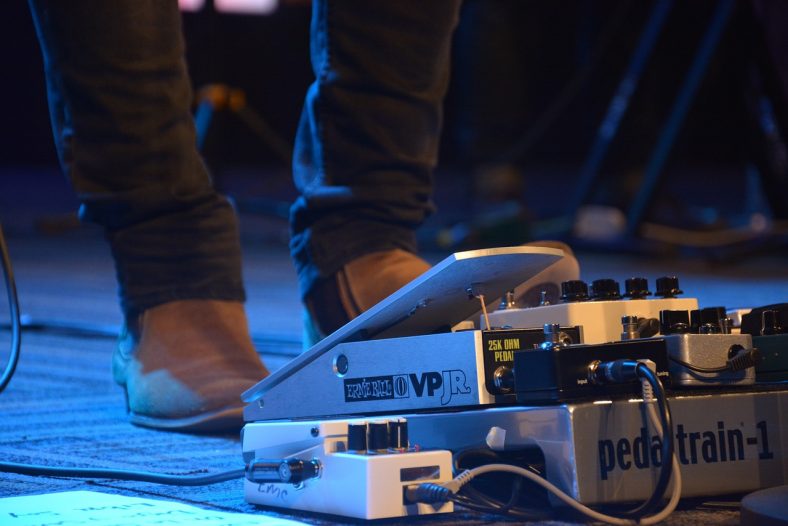Ibanez Tube Screamer Review – The Iconic Overdrive Pedal

Please note: this article contains information about multiple versions of the Ibanez Tube Screamer (TS 808 and TS 9) and some other alternative overdrive pedal options.
The Ibanez Tube Screamer is one of the most iconic overdrive pedals in the world. For almost four decades, this small green box shaped the tone of millions of guitarists around the world. Famous for its super-bright tone, the Tube Screamer has been around since the late 70’s.
We have seen numerous versions and derivates for all these years, but original TS 808 and TS 9 models are still the most beloved versions of this legend. There are so many guitarists that have used or still use this pedal.
Contents
The original Tube Screamer was popularized by Stevie Ray Vaughn, while nowadays it is an integral part of pedalboards of guitar gods like Eric Johnson, Stevie Vai, John Petrucci, Andy Timmons, Joe Bonamassa, and many others.
Today, the Tube Screamer and its clones are used by pretty much every blues and rock guitarist. Its recognizable warm tone is still one of the main references when it comes to guitar tone.
The pedal has a plethora of strong points. Of course, there are few weak spots as well. So, let’s start with a brief review of this legendary piece of gear.
Ibanez Tube Screamer – Price Comparison
Ibanez Tube Screamer – History
The history of the Tube Screamer starts in the late 70s. At that time, the most popular overdrive pedals were models like Boss OD-1 and MXR Distortion +. Ibanez wanted to offer a decent competitor.
The designer of the original Tube Screamer is Susumu Tamura and, interestingly, another legendary company, Maxon, produced the original pedal for Ibanez in first few years. These days, Maxon offers its own version of the Tube Screamer, simply called Overdrive. The two pedals sound very similar, though Maxon Overdrive features a little bit higher price.
The first model comes with the TS808 designation. A few years later, in 1982, the pedal received few changes. This model is known as the TS9. It featured the same JRC4558D op-amp, though the newer TS9 featured different output which resulted in a slightly different tone, less smooth and brighter.
This version was produced until 1985. Since then, we have seen various versions, with different kinds of modifications. However, the first two models turned out to be the most popular, even today.
Design
Today, Ibanez offers a plethora of overdrive pedals under Tube Screamer name. Besides original TS808 and TS9 models, you can find variations like Turbo Tube Screamer, Tube Screamer with Booster, small-size Tube Screamer Mini, or even a pedal designed for the bass guitar.
Let’s stick to original models, TS808 and TS9. In terms of base design, these two pedals are pretty much the same. They feature a rather simple layout. Dimensions are the same, as well as the controls configuration.
There are three pots – Overdrive, Tone, and Level. Seems like a common combination of controls, so tweaking is quite simple. These three pots feature slightly different shape and color on two pedals but bigger differences are the notable on/off switches.
The TS808 comes with the original small rectangular switch, while the one on TS9 is bigger and more massive, and seems more durable.
Finally, there are Input and Output, as well as a power supply jack. All in all, a very common pedal design.
Sound
The tone is definitely the thing that makes Tube Screamer so special. It is definitely one of the most famous overdrive tones in the history of the electric guitar.
As I’ve already mentioned, the pedal is based on the well-known, pretty simple JRC4558D chip, which has been used in so many pedals. However, things like an anti-parallel arrangement of dual silicon diodes, different wiring and a plethora of other design solutions are the reason why the Tube Screamer delivers such a unique tone.
When someone hears this pedal, the first attribute that comes to his mind is ‘warm’. This pedal sounds so warm and it is the thing that makes it perfect for blues, rock, and all other old-school music styles.
In most cases, guitarists use this pedal for crunchy rhythm tones. Overdrive and Tone knobs give such a wide range of colors. The great thing about the Tube Screamer is that it works amazingly in all situations.
It’s not a rare thing to see a player who combines it with amp’s distortion, or even with other pedals. This pedal is a perfect booster and could give you a whole new spectrum of tone nuances.
If you want to use this pedal for soloing, you must be aware that this is an old-school overdrive pedal. It doesn’t offer too much gain and definitely isn’t designed for heavier music genres, mainly because of its warm character. Still, if you have a good boost pedal, such combination would give you a pretty decent amount of gain for hard rock and similar genres.
As I’ve already mentioned, two pedals feature a slightly different tone. The TS9 comes with a different output, which causes an even warmer and less smooth tone. Without any doubt, both models sound spectacular and the choice between these two would be an extremely hard task in my case.
Verdict
Without any doubt, the Tube Screamer is a pedal you should at least try. It is one of the most essential pedals in the history of the electric guitar, something that millions of guitar players have on their pedalboards.
No matter the genre or playing style, you can get lots of beautiful tones from this small green box. Most pedals require lots of tweaking to find a tone you want. This one is different. No matter what you do with pots, it will sound amazing but, importantly, always different.
You’ve already realized that the tone is the strongest point of this pedal. However, it is also extremely durable. The housing is made of steel, while the switch seems so durable that decades of use are guaranteed.
On the other side, the price could seem a little bit high for some. Still, consider that this is one of the most iconic guitar pedals of all time and that such reputation affects the price too. If you want to save some money, there is a great alternative called Ibanez Tube Screamer Mini.
See the Ibanez Tube Screamer Mini in action in our video review:
Not only that it’s significantly cheaper, but also won’t occupy too much space on your pedalboard. On the other side, it delivers a genuine Tube Screamer tone, pretty much on par with TS808 and TS9 model.
Check out our guide on how to setup a guitar pedalboard.
Cheaper copies of the Ibanez Tube Screamer?
Another good way to save money is to buy one of the numerous clones. This is one of the most copied guitar pedals around, with dozens of clones. Some of them even come from highly reputable brands, while some are products of small craft companies.
In all cases, it is easy to recognize them, because all of them have one or more features that clearly point to the original Tube Screamer. For example, most of these pedals are green, and in most cases have something like “tube”, “scream” or “808” in its name.
For example, pedals like Behringer TO800 or Joyo JF-01 would be a great choice. A decent TS sound for three-times less money.
Another interesting pedal, Electro-Harmonix East River Drive, is pretty much a Tube Screamer clone, which offers amazing quality for the price.
You can also find clones that are actually more expensive than the original model. For example, there is a pedal called JHS Bonsai 9 Way Screamer, which puts pretty much all tube screamers in a single stompbox. It seems expensive, but you actually get multiple pedals in a single housing.






